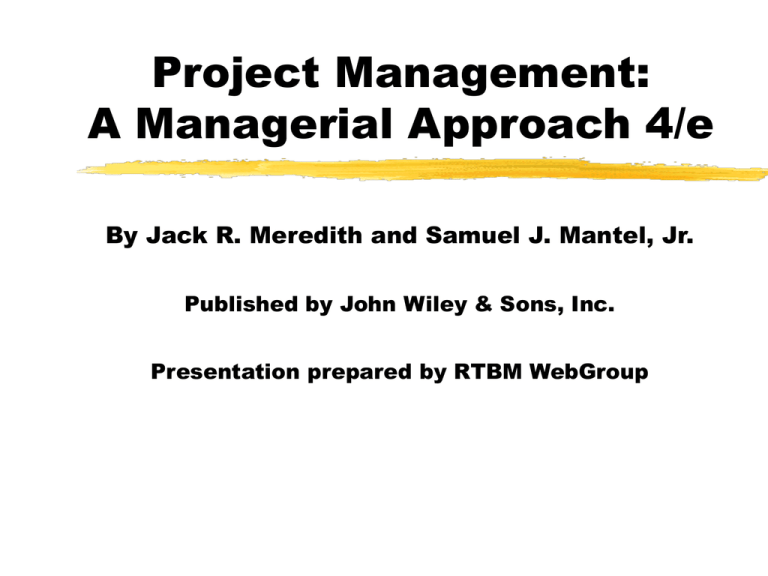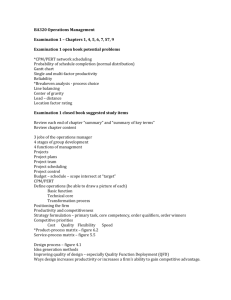
Project Management:
A Managerial Approach 4/e
By Jack R. Meredith and Samuel J. Mantel, Jr.
Published by John Wiley & Sons, Inc.
Presentation prepared by RTBM WebGroup
Project Management
A Managerial Approach
Chapter 9
Resource Allocation
Critical Path Method Crashing a Project
CPM includes a way of relating the
project schedule to the level of physical
resources allocated to the project
This allows the project manager to
trade time for cost, or vice versa
In CPM, two activity times and two
costs are specified, if appropriate for
each activity
Chapter 9-1
Critical Path Method Crashing a Project
The first time/cost combination is called
normal, and the second set is referred to
as crash
Normal times are “normal” in the same
sense as the ‘m’ time estimate of the
three times used in PERT
Crash times result from an attempt to
expedite the activity by the application of
additional resources
Chapter 9-2
Critical Path Method Crashing a Project
Careful planning is critical when
attempting to expedite (crash) a project
Expediting tends to create problems;
and the solution to one problem often
creates several more problems that
require solutions
Some organizations have more than
one level of crashing
Chapter 9-3
Fast-Tracking
Another way to expedite a project is
known as “fast-tracking”
It refers to overlapping the design and
build phases of a project
Because design is usually completed
before construction starts, overlapping
the two activities will result in shortening
the project duration
Chapter 9-4
The Resource Allocation
Problem
A shortcoming of most scheduling
procedures is that they do not address the
issues of resource utilization and availability
Scheduling procedures tend to focus on
time rather than physical resources
Time itself is always a critical resource in
project management, one that is unique
because it can neither be inventoried nor
renewed
Chapter 9-5
The Resource Allocation
Problem
Schedules should be evaluated not merely
in terms of meeting project milestones, but
also in terms of the timing and use of
scarce resources
A fundamental measure of the project
manager’s success in project management
is the skill with which the trade-offs among
performance, time, and cost are managed
Chapter 9-6
The Resource Allocation
Problem
The extreme points of the relationship
between time use and resource use are
these:
Time Limited: The project must be finished by
a certain time, using as few resources as
possible. But it is time, not resource usage, that
is critical
Resource Limited:The project must be finished
as soon as possible, but without exceeding some
specific level of resource usage or some general
resource constraint
Chapter 9-7
The Resource Allocation
Problem
If all three variables - time, cost,
specifications - are fixed, the system is
“overdetermined”
In this case, the project manager has lost all
flexibility to perform the trade-offs that are so
necessary to the successful completion of
projects
A system-constrained task requires a fixed
amount of time and known quantities of
resources
Chapter 9-8
Resource Loading
Resource loading describes the amounts of
individual resources an existing schedule
requires during specific time periods
The loads (requirements) of each resource
type are listed as a function of time period
Resource loading gives a general
understanding of the demands a project or set
of projects will make on a firm’s resources
Chapter 9-9
Resource Loading
An excellent guide for early, rough project
planning
Because the project action plan is the source
of information on activity precedences,
durations, and resources requirements, it is
the primary input for both the project
schedule and its budget
The action plan links the schedule directly to
specific demands for resources
Chapter 9-10
Resource Loading
The PERT/CPM network technique can be
modified to generate time-phased resource
requirements
The project manager must be aware of the
ebbs and flows of usage for each input
resource throughout the life of the project
It is the project manager’s responsibility to
ensure that the required resources, in the
required amounts, are available when and
where they are needed
Chapter 9-11
Resource Leveling
Resource leveling aims to minimize the periodby-period variations in resource loading by
shifting tasks within their slack allowances
The purpose is to create a smoother distribution
of resource usage
Several advantages include:
Less hands-on management is required
May be able to use a “just-in-time” inventory policy
Chapter 9-12
Resource Leveling
When resources are leveled, the associated
costs also tend to be leveled
The project manager must be aware of the
cash flows associated with the project and of
the means of shifting them in ways that are
useful to the parent firm
Resource leveling is a procedure that can be
used for almost all projects, whether or not
resources are constrained
Chapter 9-13
Constrained Resource
Scheduling
There are two fundamental approaches to
constrained allocation problems:
Heuristic Methods
Optimization Models
Heuristic approaches employ rules of thumb that
have been found to work reasonably well in similar
situations
Optimization approaches seek the best solutions but
are far more limited in their ability to handle
complex situations and large problems
Chapter 9-14
Heuristic Methods
Heuristic approaches to constrained resource
scheduling problems are in wide, general use
for a number of reasons:
1. They are the only feasible methods of attacking
the large, nonlinear, complex problems that tend to
occur in the real world of project management
2. While the schedules that heuristics generate may
not be optimal, they are usually quite good- certainly
good enough for most purposes
Chapter 9-15
Heuristic Methods
Most heuristic solution methods start with the
PERT/CPM schedule and analyze resource
usage period by period, resource by resource
In a period when the available supply of a
resource is exceeded, the heuristic examines
the tasks in that period and allocates the
scarce resource to them sequentially, according
to some priority rule
Technological necessities always take
precedence
Chapter 9-16
Heuristic Methods
Common priority rules:
As soon as possible
As late as possible
Shortest task first
Most resources first
Minimum slack first
Most critical followers
Most successors
Arbitrary
Chapter 9-17
Heuristic Methods
Most priority rules are simple adaptations of the heuristics
used for the traditional “job shop scheduling” problem of
production/operations management
Most heuristics use a combination of rules: a primary rule,
and a secondary rule to break ties
As the scheduling heuristic operates, one of two events
will result:
The routine runs out of activities before it runs out of resources
The routine runs out of resources before all activities have been
scheduled
Chapter 9-18
Optimizing Methods
The methods to find an optimal solution to
the constrained resource scheduling
problem fall into two categories:
Mathematical programming
Enumeration
Mathematical programming can be thought
of as liner programming (LP) for the most
part
Chapter 9-19
Optimizing Methods
Linear programming is usually not feasible for
reasonably large projects where there may be
a dozen resources and thousands of activities
In the late 1960s and early 1970s, limited
enumeration techniques were applied to the
constrained resource problem
Tree search, and branch and bound methods
were devised to handle up to five resources
and 200 activities
Chapter 9-20
Multiproject Scheduling
and Resource Allocation
The most common approach to scheduling and
allocating resources to multiple projects is to treat
the several projects as if they were each elements
of a single large project
Another way of attacking the problem is to
consider all projects as completely independent
To describe such a system properly, standards are
needed by which to measure scheduling
effectiveness
Chapter 9-21
Multiproject Scheduling
and Resource Allocation
Three important parameters affected by
project scheduling are:
Schedule slippage
Resource utilization
In-process inventory
The organization (or the project manager)
must select the criterion most appropriate for
its situation
Chapter 9-22
Multiproject Scheduling
and Resource Allocation
Schedule slippage, often considered the most
important of the criteria, is the time past a
project’s due date or delivery date when the
project is completed
Resource utilization is of particular concern to
industrial firms because of the high cost of
making resources available
The amount of in-process inventory concerns the
amount of work waiting to be processed because
there is a shortage of some resource
Chapter 9-23
Multiproject Scheduling
and Resource Allocation
All criteria cannot be optimized at the same
time
As usual, the project manager will have to
make trade-offs among the criteria
A firm must decide which criterion to
evaluate its various scheduling and
resource allocation options
Chapter 9-24
Mathematical Programming
Mathematical programming can be used to
obtain solutions to certain types of multiproject
scheduling problems
These procedures determine when an activity
should be scheduled, given resource constraints
Mathematical programming, however, is rarely
used in project management to handle the
multiproject problem (mostly, heuristics are
used)
Chapter 9-25
Mathematical Programming
The three most common objectives of
mathematical programming are:
1. Minimum total throughput time (time in the shop) for all
projects
2. Minimum total completion time for all projects
3. Minimum total lateness or lateness penalty for all projects
These objectives are most appropriate for ‘job
shop’ type solutions to resource constraints
Chapter 9-26
Heuristic Techniques
There are scores of different heuristic-based
procedures in existence
They represent rather simple extensions of
well-known approaches to job-shop
scheduling:
Resource Scheduling Method
Minimum late finish time
Greatest resource demand
Greatest resource utilization
Most possible jobs
Chapter 9-27
Summary
The critical path method (CPM) is a network
constructed in the same manner as PERT but
considers the possibility of adding resources
to tasks to shorten their duration
The resource allocation problem is concerned
with determining the best trade-offs between
available resources, including time,
throughout the duration of the project
Chapter 9-28
Summary
Resource loading is the process of
calculating the total load from project tasks
on each resource for each time period of the
project’s duration
Resource leveling is concerned with evening
out the demand for various resources
required in a project by shifting tasks within
their slack allowances
Chapter 9-29
Summary
There are two basic approaches to addressing
the constrained resources allocation problem:
Heuristic methods
Optimizing methods
For multiproject scheduling, three important
measures of effectiveness are schedule
slippage, resource utilization, and level of inprocess inventory
Chapter 9-30
Summary
When a new project is added to a multiproject
system, the amount of slippage is directly
related to the average resource load
Mathematical programming models for
multiproject scheduling aim to either minimize
total throughput time for all projects, minimize
the completion time for all projects, or
minimize total lateness for all projects
Chapter 9-31
Resource Allocation
Questions?
Chapter 9-32
Resource Allocation
Picture Files
Resource Allocation
Figure 9-1
Resource Allocation
Figure 9-2
Resource Allocation
Figure 9-3
Resource Allocation
Figure 9-4
Resource Allocation
Figure 9-5
Resource Allocation
Figure 9-6
Resource Allocation
Figure 9-7
Resource Allocation
Figure 9-8
Resource Allocation
Figure 9-9a
Resource Allocation
Figure 9-9b
Resource Allocation
Figure 9-10
Resource Allocation
Figure 9-11
Resource Allocation
Figure 9-12
Resource Allocation
Figure 9-13
Resource Allocation
Figure 9-14
Resource Allocation
Figure 9-15
Resource Allocation
Figure 9-16
Resource Allocation
Table Files
Resource Allocation
Resource Allocation
Resource Allocation
Copyright © 2000 John Wiley & Sons, Inc. All rights
reserved. Reproduction or translation of this work
beyond that permitted in Section 117 of the 1976 United
States Copyright Act without the express written
permission of the copyright owner is unlawful. Request
for further information should be addressed to the
Permissions Department, John Wiley & Sons, Inc. The
purchaser may make back-up copies for his/her own use
only and not for distribution or resale. The Publisher
assumes no responsibility for errors, omissions, or
damages, caused by the use of these programs or from
the use of the information contained herein.





